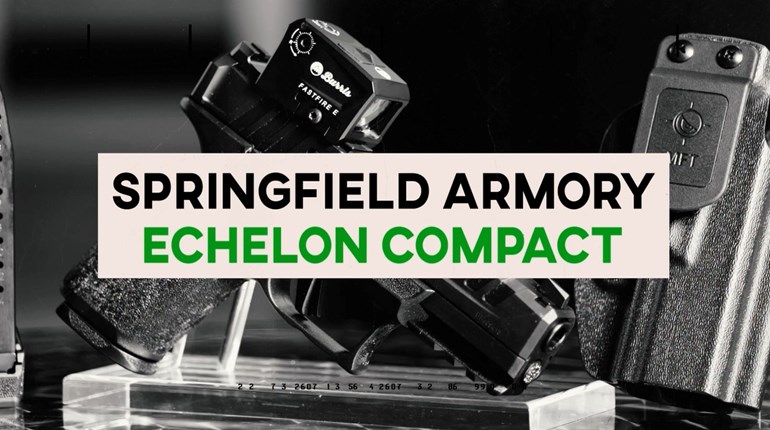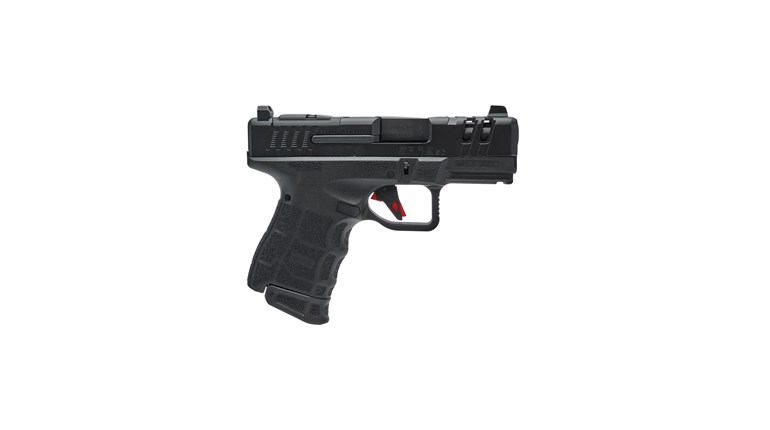
This feature appears in the February ‘17 issue of NRA America’s 1st Freedom, one of the official journals of the National Rifle Association.
We doubt it would surprise a single reader that our “wow” meter is pretty much pegged with this month’s Wilson Combat AR9B carbine. We’d pardon those completely unfamiliar with gunsmith Bill Wilson’s gear—a very small number, we’d wager—and suggest that such a count will be smaller still very soon: His take on the pistol caliber carbine (PCC) is a secret we surely have no desire to keep.
A little background may be useful. Americans have long valued pistol cartridges in correspondingly chambered rifles as a way to harvest the full potential of handgun ammunition. Indeed, “The Gun That Won The West,” Winchester’s Model 1873 in .44-40, is a—perhaps even the—classic example. More obvious still was the utility of feeding both a long and short arm from the same cartridge box, yet maintaining the advantages of either for differing applications. Ahhhhh, American ingenuity.But it would be a mistake to peg the Wilson as merely another wave on an increasingly crowded sea of pistol caliber carbines.
Now 144 years hence, the appearance of a modern analog is therefore not surprising.
Another non-surprise is manifest in our example of that analog—the Wilson Combat AR9. Why we omit the “B” will become clear directly, but tube feeding, lever action, and buckhorn/notch and post sights have been replaced by detachable “box” magazines, semi-automatic function and “whatever sight you like” aiming options befitting the 21st century (like the splendid Aimpoint Carbine Optic). It doesn’t take much of an eye to see how: Courtesy of the modern sporting rifle, such versatilities come with almost trivial ease.

But it would be a mistake to peg the Wilson as merely another wave on an increasingly crowded sea of pistol caliber carbines. Billet-born “uppers” and “lowers” accept virtually all the custom furniture and fitments that have made the MSR/AR vastly popular, yet it is still loaded with native features that set it at least apart from—if not well above—most competitors. You can add goodies of your choosing, but we think astonishingly few will feel the need to.
Three features fairly leap off the rifle when the initial “oooohs” and “ahhhhs” give way to actual range work. In a very close race, our favorite is the bolt hold-open. These are rare on PCCs because they require a fairly substantial rework of the heart of the Stoner/Armalite-pattern lower. In combination with the blowback action and the very different dimensions of 9 mm magazines compared to .223 Rem./5.56x45 mm NATO, most PCCs just give this capacity up. And it is survivable. But with the Wilson, you won’t have to: An empty mag locks the proprietary bolt to the rear, and means the carbine runs in mechanically identical fashion to a rifle-caliber MSR in every particular.
The barrel and comp combination “placed;” in other words, the fit is spot-on. The button-rifled, 1-10 twist, match-grade tube is mated with a 9 mm-optimized comp that made the rifle beautifully tranquil in the hands. Rapid, accurate multiples always demand practice, but our Wilson was so docile (and precise, due to the TTU trigger) that we could compound the energy of four shots on a 12-inch steel target fast enough to knock it over, stand and all.
Conventional accuracy, too, was superb. Remember that pistol bullets are simply not designed for long-range shooting, and their ballistic coefficients may be a third of rifle bullets of the same mass. Nevertheless, we had repeated groups of five shots hovering at an inch with a variety of weights. The quick twist rate is no doubt a major factor here, especially for heavier projectiles.
In the “show” position is the magazine well, and where we get back to our misplaced “B” designation. Most manufacturers of PCCs commit themselves to a single pistol magazine type for their carbines, and we can’t find fault, exactly; it’s a reflection of engineering and manufacturing realities that can’t be ignored. A bottom line eventually looms, no matter how ardent the effort to keep it at bay may be.
But with 40-plus years on the edge of the art, the engineering prowess that staked the Wilson Combat reputation in other areas comes decisively home in their PCCs—three possible magazine choices are available. In addition to our Beretta, you can multitask your store of Glock or Smith & Wesson M&P pistol magazines, ordering a rifle tailor-made for any one of the three. (In an apparent fit of imagination, these are, respectively, the “G,” and “S” variants.) Did we neglect to mention the magazine well is also a major funnel? If you miss a reload here, we can only suggest more practice. Yes, we know: “Oh, darn.”
We’re obvious fans of the PCC, and we see no evidence that the advantages of a single cartridge for both a long and short arm are any less compelling now than they were in the heyday of the .44-40. We think, in fact, that the evidence heads in the other direction: The Wilson Combat AR9 burnishes a good 19th-century idea into 21st-century perfection. We’re obvious fans of the PCC, and we see no evidence that the advantages of a single cartridge for both a long and short arm are any less compelling now than they were in the heyday of the .44-40.
NUTS AND BOLTS:
But “why,” again? We lay it off on Mom—certainly no inherent good character trait accounts for it—but we don’t mind sharing when we’re at the range. This is particularly so with a rifle of the excellence implicit in the AR9. But if we noticed a reaction other than consistent glee, it was peevish resistance to the rationale for common pistol/rifle ammunition.
We’ve no urge to grow unpleasant, but we posit this as absurd. Of course, no firearm or cartridge erases all challenges or meets every need. But a PCC in the long role accompanied by a great Glock, Smith or Beretta in the short does a huge number of things well, or rather very well, and the Wilson especially so. For starters, consider all the places you can shoot 9 mm where even the modest 5.56x45 mm NATO/.223 Rem. is heartily unwelcome, and all the targets—steel especially comes to mind—that you can’t engage with other-than-pistol calibers. All are back in play, as well as great training (and fun) venues like the new PCC class in USPSA.
In “work” roles (like duty/personal defense), the 9 mm PCC adds a second advantage—that of a substantial energy boost without dramatically increasing over-penetration risk. Over a wide range of bullet types, we found 25 percent bumps common and essentially free. The rifle platform controls both muzzle movement and recoil in splendid fashion, yet the same ammo remains very manageable in a good-quality handgun.

An AR9 is also a superb way to teach the MSR/AR platform to a new(er) or lighter-statured shooter. Just enough less recoil, muzzle blast and report than a gas-driven rifle make it a delight for almost anyone. The thrifty Scot in us lodges a final adjunct claim: Unless you are vastly better-connected than most, every pull of the trigger will also yield about 90 percent of the value of rifle caliber practice but at 60 percent of the cost. But fair warning—order your 9 mm by the case (or pallet).
A Custom Gun
If you decide a Wilson Combat AR9 is for you (highly recommended, in case you’re still wondering), we have a warning, of sorts: You’ll be getting a custom gun. Without belaboring the explanation, this means it will have tolerances the like of which no previous firearms have likely prepared you for. This emphatically doesn’t mean it won’t be a joy and value from day—er, shot-—one, but the same tolerances that will let it run trouble-free for years may translate into a little balkiness at first. Take our emphatic word for it: Perfect functioning isn’t long away, and is utterly worth the wait.

































